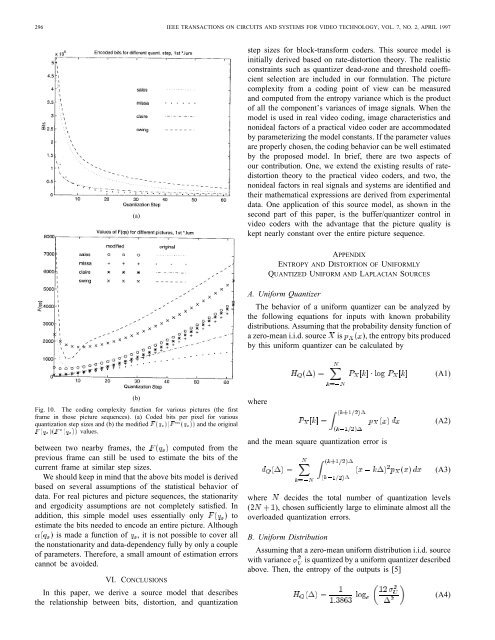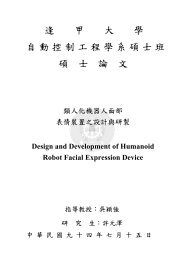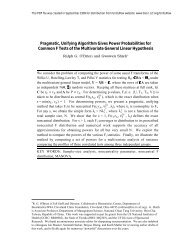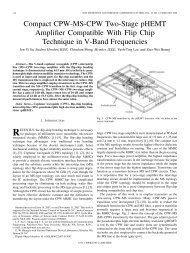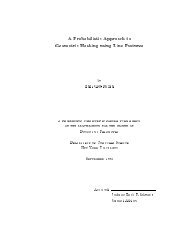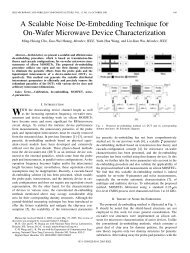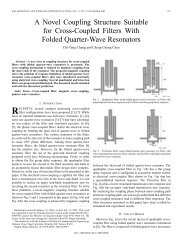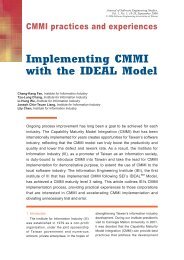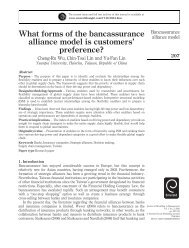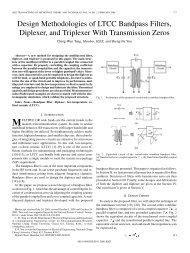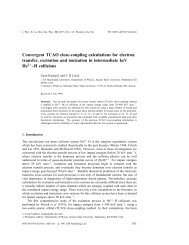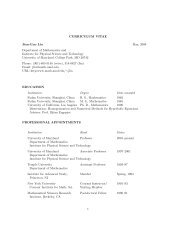Source Model for Transform Video Coder and its ... - ResearchGate
Source Model for Transform Video Coder and its ... - ResearchGate
Source Model for Transform Video Coder and its ... - ResearchGate
You also want an ePaper? Increase the reach of your titles
YUMPU automatically turns print PDFs into web optimized ePapers that Google loves.
296 IEEE TRANSACTIONS ON CIRCUITS AND SYSTEMS FOR VIDEO TECHNOLOGY, VOL. 7, NO. 2, APRIL 1997<br />
(a)<br />
step sizes <strong>for</strong> block-trans<strong>for</strong>m coders. This source model is<br />
initially derived based on rate-distortion theory. The realistic<br />
constraints such as quantizer dead-zone <strong>and</strong> threshold coefficient<br />
selection are included in our <strong>for</strong>mulation. The picture<br />
complexity from a coding point of view can be measured<br />
<strong>and</strong> computed from the entropy variance which is the product<br />
of all the component’s variances of image signals. When the<br />
model is used in real video coding, image characteristics <strong>and</strong><br />
nonideal factors of a practical video coder are accommodated<br />
by parameterizing the model constants. If the parameter values<br />
are properly chosen, the coding behavior can be well estimated<br />
by the proposed model. In brief, there are two aspects of<br />
our contribution. One, we extend the existing results of ratedistortion<br />
theory to the practical video coders, <strong>and</strong> two, the<br />
nonideal factors in real signals <strong>and</strong> systems are identified <strong>and</strong><br />
their mathematical expressions are derived from experimental<br />
data. One application of this source model, as shown in the<br />
second part of this paper, is the buffer/quantizer control in<br />
video coders with the advantage that the picture quality is<br />
kept nearly constant over the entire picture sequence.<br />
APPENDIX<br />
ENTROPY AND DISTORTION OF UNIFORMLY<br />
QUANTIZED UNIFORM AND LAPLACIAN SOURCES<br />
A. Uni<strong>for</strong>m Quantizer<br />
The behavior of a uni<strong>for</strong>m quantizer can be analyzed by<br />
the following equations <strong>for</strong> inputs with known probability<br />
distributions. Assuming that the probability density function of<br />
a zero-mean i.i.d. source is , the entropy b<strong>its</strong> produced<br />
by this uni<strong>for</strong>m quantizer can be calculated by<br />
(A1)<br />
(b)<br />
Fig. 10. The coding complexity function <strong>for</strong> various pictures (the first<br />
frame in those picture sequences). (a) Coded b<strong>its</strong> per pixel <strong>for</strong> various<br />
quantization step sizes <strong>and</strong> (b) the modified F (q s )(F m (qs)) <strong>and</strong> the original<br />
F (qs)(F o (qs)) values.<br />
between two nearby frames, the computed from the<br />
previous frame can still be used to estimate the b<strong>its</strong> of the<br />
current frame at similar step sizes.<br />
We should keep in mind that the above b<strong>its</strong> model is derived<br />
based on several assumptions of the statistical behavior of<br />
data. For real pictures <strong>and</strong> picture sequences, the stationarity<br />
<strong>and</strong> ergodicity assumptions are not completely satisfied. In<br />
addition, this simple model uses essentially only to<br />
estimate the b<strong>its</strong> needed to encode an entire picture. Although<br />
is made a function of , it is not possible to cover all<br />
the nonstationarity <strong>and</strong> data-dependency fully by only a couple<br />
of parameters. There<strong>for</strong>e, a small amount of estimation errors<br />
cannot be avoided.<br />
VI. CONCLUSIONS<br />
In this paper, we derive a source model that describes<br />
the relationship between b<strong>its</strong>, distortion, <strong>and</strong> quantization<br />
where<br />
<strong>and</strong> the mean square quantization error is<br />
(A2)<br />
(A3)<br />
where decides the total number of quantization levels<br />
( ), chosen sufficiently large to eliminate almost all the<br />
overloaded quantization errors.<br />
B. Uni<strong>for</strong>m Distribution<br />
Assuming that a zero-mean uni<strong>for</strong>m distribution i.i.d. source<br />
with variance is quantized by a uni<strong>for</strong>m quantizer described<br />
above. Then, the entropy of the outputs is [5]<br />
(A4)


